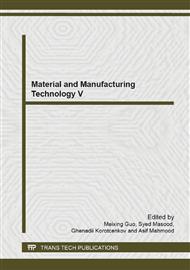p.183
p.188
p.195
p.199
p.205
p.210
p.215
p.220
p.225
Simulation of Dirac Tunneling Current of an Armchair Graphene Nanoribbon-Based P-N Junction Using a Transfer Matrix Method
Abstract:
We have studied tunneling current in a p-n junction based on armchair graphene nanoribbon (AGNR) by using the relativistic Dirac equation and a transfer matrix method (TMM). The electron wave function was derived by solving the relativistic Dirac equation. The TMM, which is a numerical approach, was used to calculate electron transmittance and the tunneling current. The results showed that the tunneling current increases with the bias voltage. On the other hand, the tunneling current increases with the decreases in the electron incidence angle and temperature. Moreover, the increases in the AGNR width and electric field in the p-n junction result in the increase in the tunneling current.
Info:
Periodical:
Pages:
205-209
Citation:
Online since:
June 2014
Price:
Сopyright:
© 2014 Trans Tech Publications Ltd. All Rights Reserved
Share:
Citation:



